VRWC Specific Pages
- Home
- Stu's Walker of the Week
- 2025 Winter Season NEW
- VRWC Membership and Race Entry
- VRWC Uniforms
- VRWC Calendar
- VRWC Road Courses
- Parking at VRWC Events
- VRWC Comp. Rules and Fees
- VRWC By-Laws and Policies
- VRWC Committee
- VRWC/AV Awards Trophies
- International Representatives
- VRWC Life Members
- VRWC Past Club Executives
- VRWC Annual Reports
- VRWC Club History
- VWRC Photo Galleries
- VRWC Articles Archive
- VRWC Internet Newsletters
- VRWC and AthsVic Videos
- VRWC Points Competitions
- Coaching Initiatives
- How Age Groups work
- 2017 VRWC Falls Creek Camp
- VRWC Runners World Awards
The Rules of Racewalking
- A History of the Racewalking Rules
- The current WA Racewalking Rules
- Judging - Australian Specific ByLaws
- The Racewalking Rules Explained
- Club Rules Explained
- Possible Technological Rule Changes
Records Records Records
Supporting the 50km
Other Pages
- Tim's Racewalking Quiz
- Liability and Insurance
- Vic. Championship results
- 1956 Olympic Reflections
- 2000 Olympic Torch pictures
- Racewalking around Australia
- Articles of General Interest
- Race Walking Book Archive NEW
- Tim's Australian Ranking Lists
- Old Australian 10km Rankings
- Racewalking Postage Stamps
- Racewalking Postmarks and FDCs
- Hiking and Walking Stamps
- Racewalking Cartoons
- RWA Championship Results
- Aust Championship Results
- Training Safely
- Tim's Yearly Top Tens
- Australian Honours
VRWC Results
- Winter 2025 NEW
- Summer 2024/2025
- Winter 2024
- Summer 2023/2024
- Winter 2023
- Summer 2022/2023
- Winter 2022
- Summer 2021/2022
- Winter 2021
- Summer 2020/2021
- Winter 2020
- Summer 2019/2020
- Winter 2019
- Summer 2018/2019
- Winter 2018
- Summer 2017/2018
- Winter 2017
- Summer 2016/2017
- Winter 2016
- Summer 2015/2016
- Winter 2015
- Summer 2014/2015
- Winter 2014
- Summer 2013/2014
- Winter 2013
- Summer 2012/2013
- Winter 2012
- Summer 2011/2012
- Winter 2011
- Summer 2010/2011
- Winter 2010
- Summer 2009/2010
- Winter 2009
- Summer 2008/2009
- Winter 2008
- Summer 2007/2008
- Winter 2007
- Summer 2006/2007
- Winter 2006
- Summer 2005/2006
- Winter 2005
- Summer 2004/2005
- Winter 2004
- Summer 2003/2004
- State League 2003/2004
- Winter 2003
- Summer 2002/2003
- State League 2002/2003
- Winter 2002
- Summer 2001/2002
- Winter 2001
- Summer 2000/2001
- Winter 2000
- Summer 1999/2000
- Winter 1999
- Summer 1998/99
- Winter 1991-1998
- Summer 1991-1998
Other Walking Sites

1956 Olympic Games 20 km Racewalk

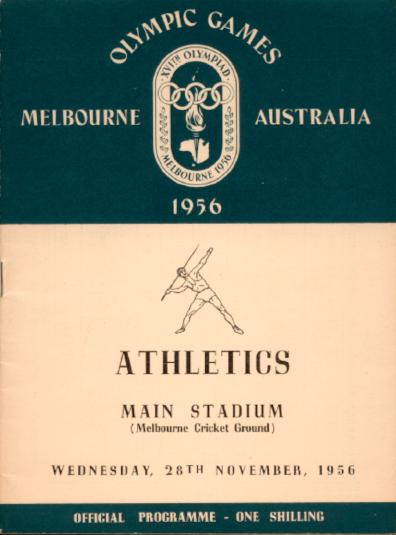 The Athletics Program cover for 28 November
1956 - the day of the 20 km
racewalk
The Athletics Program cover for 28 November
1956 - the day of the 20 km
racewalk
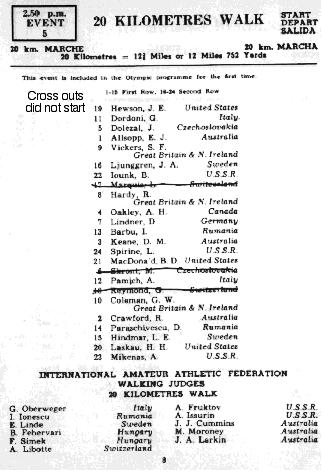
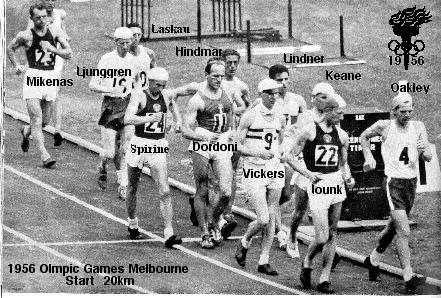
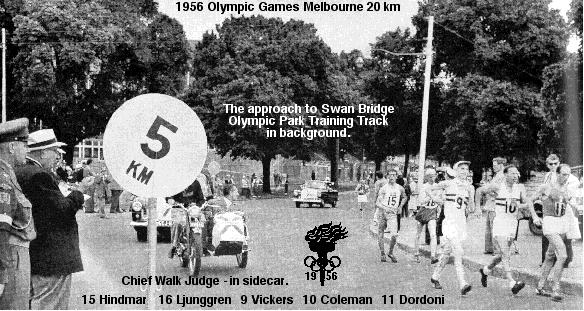
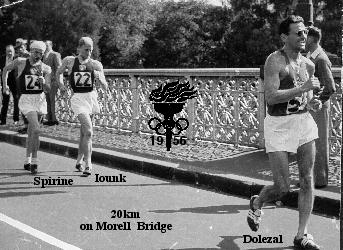
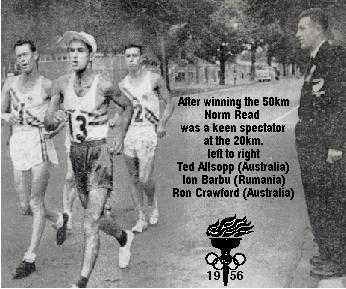
1956 OLYMPIC 20KM WALK - BRITISH OLYMPIC ASSOCIATION - OFFICIAL REPORT BY JACK CRUMP
THE judges who adjudicated in the 50 kilometres walking event
also
officiated here, but they failed to show the same strictness as in
the
longer race and the standard of walking was certainly far from that
expected
in an Olympic contest. Twenty-one started in this new Olympic event,
which
took place in very much cooler conditions than those experienced by
the
longer distance walkers.
Oakley, of Canada, led going out of the stadium for the first of the
2,000 metres laps; but it was no surprise when he was
disqualified.
At five kilometres, Dolezal, of Czechoslovakia, was a foot ahead
of Coleman and Vickers. of Great Britain, with the Swedish pair,
Ljunggren and Hindmar, a yard or so behind. At the half-distance,
Dolezal and Ljunggren were the leaders in 45 minutes -36 seconds,
Mikenas, one second behind, having four seconds in hand over
Coleman
and Vickers. Junk and Spirin, of the U.S.S.R., were then Iying
ninth,
71 seconds slower than the leaders.
It was at this point that the Soviet challenge developed fully, and
at 15 kilometres Mikenas had a 13 seconds' lead of Ljunggren,
while
Spirin had reduced the leeway by coming up to third place.
Dolezal
tired and, having gone back to fifth place, 20 yards behind
Vickers,
dropped out shortly afterwards. Spirin, walking fast but far from
stylishly, went to the front just before the walkers reached the
stadium and was followed m by Mikenas, with Junk a close third to
provide the U.S.S.R. with a clean sweep of the medals.
Ljunggren made a courageous effort to ward off the mass Soviet
challenge
and did magnificently, in view of his efforts in the longer race,
to finish fourth, and the best stylist of the leading men,
Vickers,
in his first international race, performed splendidly to occupy
fifth
place, gaining slightly on Ljunggren in the last five kilometres.
The Australian Keane, did well to split split the English trio,
of
whom Hardy was affected by a caution which caused him to slow
down
considerably. Seventeen finished, Dolezal, Lindner and Hindmar
retiring.
Oakley was the only man to be disqualified, although leniency on
the part of the judges explains the absence of further enforced
withdrawals.
The experiment, for such it must be regarded, of substituting a
20
kilometres road walk for the controversial 10 kilometres track walk
proved
a success, for it duly attracted the entry from the shorter
distance
men and was held without the disputes regarding the judging on
the
method of progression which occurred in the track walks at
Wembley
in 1948 and Helsinki in 1952.
I question whether there would have been quite the same absence
of
after-race criticism had the Games been held in Europe, where walking
is
much more popular and where the supporters are more enthusiastic,
more
partisan and more vocal than it is in Australia. Unquestionably,
however,
the lengthening of the distance of the sprint walk and its translation
to the road has saved the race from disappearing from the Olympic
programme.
1 L. Spirin (U.S.5.R.) 1. 31. 27.4
2 A. Mikenas (U.S.S.R.) 1. 32. 03.0
3 B. Junk (U.S.S.R.) 1. 32. 12.0
4 J. Ljunggren (Sweden) 1. 32. 14.0
5 S. Vickers (G.B.) 1. 32. 34.2
6 D. Keane (Australia) 1 .33. 52.0


